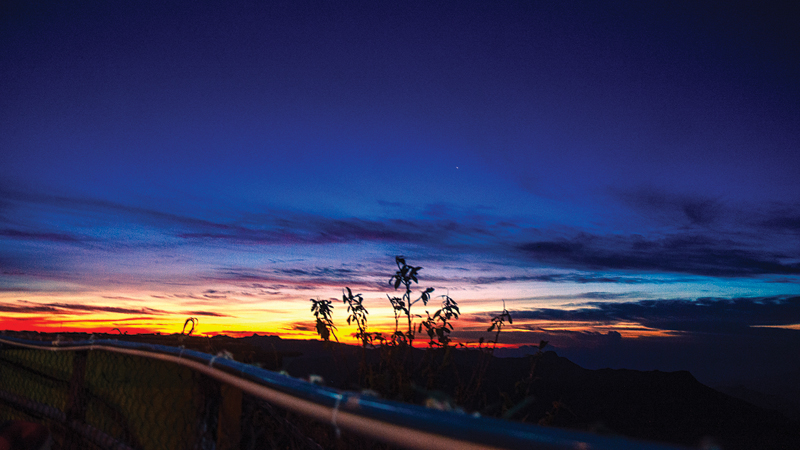 The sky and Earth are split by a golden line. Sun rays colour a panorama of hilltops. As the sun rises, the triangular silhouette of Sri Pada casts itself on the green landscape. In the background, a bell rings, as each devotee sounds out the number of times they have made the pilgrimage to the mountain peak.
The sky and Earth are split by a golden line. Sun rays colour a panorama of hilltops. As the sun rises, the triangular silhouette of Sri Pada casts itself on the green landscape. In the background, a bell rings, as each devotee sounds out the number of times they have made the pilgrimage to the mountain peak.
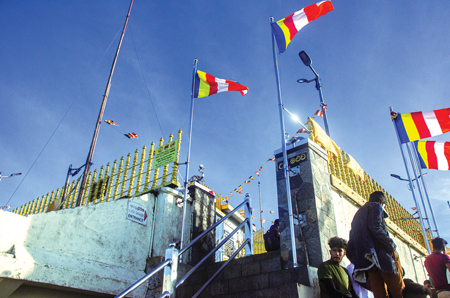
The sacred footprint in an abode on the summit
The Sri Pada, Samanalakanda, the Adam’s Peak and many other names refer to the same 2,243-metre-tall sacred mountain. The Sri Pada pilgrimage season begins on the Unduvap Full Moon Poya day in December, continues through the intervening months and ends on Vesak Full Moon Poya day in May. During this period, people of varied faiths and all walks of life make the arduous trek with great devotion to the summit.
Thousands of pilgrims visit the sacred mountain daily during the season to pay homage to the large footprint on the summit. Buddhists believe that it is the footprint of the Buddha. While the Hindus consider it the footprint of Shiva, Muslims and Christians believe that it is the footprint of Adam, the first man.
Royal patronage
The footprint is said to have been discovered by King Walagambahu (104-89 BCE), who deemed it to have been imprinted during the Buddha’s third visit to Sri Lanka. Over the centuries, King Vijayabahu and King Parakaramabahu II built shelters, cleared jungle and built paths to the mountain peak. The Ratnapura Route, Kuruwita Route and the Hatton Route are some of the main trails to the top. For those hoping to see the iconic sunrise, the journey begins at night.
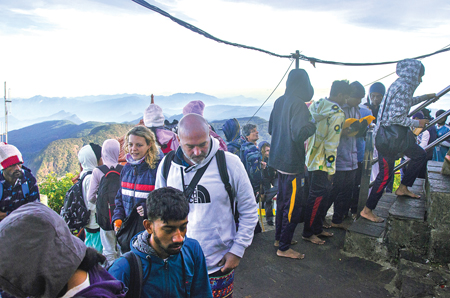
Devotees of all faiths on a pilgrimage to the top of the sacred mountain
Hikers pack for a cool night and chilly winds. The path is one that celebrates nature. It is a journey where pilgrims fortify their spirits through rhyme and song. Most importantly, discussions on the distance are taboo, as it is important to think only of reaching the summit. Along the way are shops that offer refreshment and respite for the weary soul. As the pilgrims ascend with fervour to reach the top, an important stop along the way is Seetha Gangula. The icy waters of this stream refresh those making the trek to the top. Pilgrims stop here to recite pansil, five precepts of Buddhism and make a Pandura (offering) for protection to Saman Deviyo, the guardian deity of the Sri Pada and one of the four guardian deities of Sri Lanka.
Act of devotion
Next, those who are on the trek encounter a large weave of white thread. It is called Indikatupana, and marks the place where the Buddha is believed to have stopped to mend a tear in his robe. The white web has been created by the pilgrims who observe the tradition of unravelling white thread and placing the needle at Indikatupana. From this point, the intensity of the journey heightens both spiritually and physically.
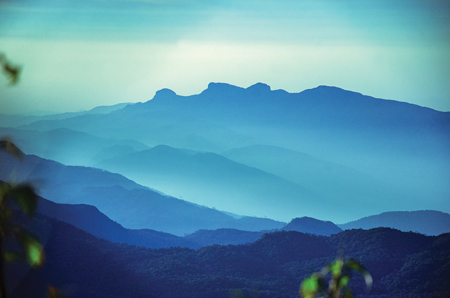
Undulating ridges of forest covered hills with morning fog
Mahagiridamba, the final stretch to the summit, is a path set on rock. Today, iron rails support the pilgrims on the journey under the stars. Near the top of the mountain is the Bhagava Cave, once the only refuge from rain or place of respite for pilgrims making the journey. There are three epigraphs at the site, two of which were authored by King Nissankamalla (1187 – 1196 CE) and the other by Arab traveller Ibn Battuta who climbed the Sri Pada in 1344 CE.
The rock plateau upon which the footprint has been imprinted is surrounded by a parapet wall. Once on the top, an ornate shrine comes into view. Here, the footprint has been enshrined.
Today, one cannot see the original footprint as it has been covered by a stone slab. During the pilgrimage season, the shrine is open for public viewing, and people flock to the door to catch a glimpse of the sacred footprint and observe their worship.
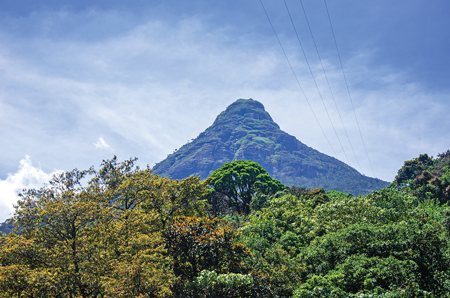
The Sri Pada, a breathtaking sight across the verdant landscape
The frequent ringing of the large silver bell near the shrine, housing the footprint, denotes the number of times a pilgrim has made the ascent to the sacred footprint of the Sri Pada. Many of the pilgrims ring it three or more times.
Reach the summit just before sunrise at 5.30 am. And what a Sunrise!!! Undulating ridges of forest covered hills with morning fog blanketing their valleys, reservoirs on either side. As dawn breaks, eyes turn towards the visual feast of the rising sun and the shadow of the mountain on the verdant plain. Many linger on the summit for some time to catch their breath and meditate amid this serenity.
Crisp air
After breathing in the crisp air and view of the Peak Wilderness Sanctuary and the Horton Plains National Park, the descent begins. Whether you make a hike or pilgrimage to Sri Pada, and no matter which path you choose, scaling this sacred mountain is a must do for many Sri Lankans and a remarkable experience for all.



